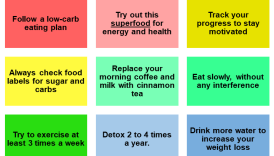Fueling Your Body Right: The Benefits of Low-Fat Living

Understanding Low-Fat Living
Low-fat living is more than just a fad diet; it’s a holistic approach to health that emphasizes making informed food choices. Many may think of low-fat as synonymous with boring salads and tasteless meals, but in reality, it’s about finding a balance that nourishes the body without unnecessary fats. For example, transitioning to a low-fat lifestyle helped a close friend of mine, who struggled with high cholesterol, discover flavorful alternatives that were both satisfying and heart-healthy. A few essential tenets of low-fat living include:
- Fueling Your Body Right: The Benefits of Low-Fat Living
- Understanding Low-Fat Living
- Importance of Proper Nutrition
- The Basics of Low-Fat Diet
- What is Low-Fat Diet?
- Key Principles of Low-Fat Living
- Benefits of Low-Fat Living
- Improved Heart Health
- Weight Management Benefits
- Nutrient-Rich Low-Fat Foods
- Fruits and Vegetables
- Whole Grains and Lean Proteins
- Low-Fat Cooking Techniques
- Baking instead of frying
- Flavorful seasoning alternatives
- Meal Planning for Low-Fat Living
- Creating Balanced Meals
- Healthy Snack Options
- Incorporating Exercise into Low-Fat Lifestyle
- Importance of Physical Activity
- Exercise Tips for Optimal Health
- Focusing on fresh, whole foods that are naturally low in fat.
- Understanding food labels to differentiate between healthy fats and unhealthy trans fats.
By bringing awareness to one’s eating habits, individuals can make healthier choices without feeling deprived.
Importance of Proper Nutrition
Proper nutrition is the backbone of a healthy life. What you eat directly impacts your energy levels, mood, and overall well-being. Consider these points:
- Enhanced Vitality: With a balanced, low-fat diet, individuals often report increased energy.
- Disease Prevention: Proper nutrition plays a pivotal role in reducing the risk of chronic diseases such as heart disease and diabetes.
By investing time in learning about low-fat living, one can reap numerous health benefits while enjoying flavorful meals and maintaining vitality. Embracing this lifestyle fosters a positive relationship with food and promotes a sense of empowerment.
The Basics of Low-Fat Diet
What is Low-Fat Diet?
A low-fat diet focuses on reducing the intake of fats, particularly saturated and trans fats, which can contribute to various health issues. Now, this doesn’t mean that all fats are bad; instead, it encourages a mindful approach to choosing healthier fat sources while limiting unhealthy ones. For instance, while my sister initially feared cutting fats would mean bland meals, she quickly discovered that using ingredients like avocado and olive oil can bring zest to dishes without overwhelming her diet. Typically, a low-fat diet consists of:
- Less than 30% of total daily calories from fat
- Prioritization of lean proteins such as chicken, turkey, fish, and legumes
- Increased consumption of fruits, vegetables, and whole grains
Key Principles of Low-Fat Living
Embracing low-fat living involves more than simply counting calories; it’s about adopting key principles that support long-term health. Some of these principles include:
- Choosing whole, unprocessed foods: These often contain naturally lower fat content.
- Reading labels: This helps individuals identify hidden fats in processed foods and develop a better understanding of what they are consuming.
- Mindful eating: Taking the time to savor meals can lead to better satisfaction and reduced overeating.
By incorporating these key principles into daily routines, individuals not only achieve a healthier lifestyle but also foster a positive relationship with food.
Benefits of Low-Fat Living
Improved Heart Health
One of the most significant benefits of adopting a low-fat lifestyle is improved heart health. When individuals reduce their intake of saturated and trans fats, they are often supporting their cardiovascular system. For example, after my dad started following a low-fat diet, his doctor noticed a remarkable drop in his cholesterol levels. This change can result from consuming healthier fats, like those found in fish and nuts, which are known to protect heart health. Key outcomes of low-fat living for heart health include:
- Lowered cholesterol levels: This can significantly reduce the risk of heart disease.
- Decreased blood pressure: Eating a diet rich in fruits, vegetables, and whole grains contributes to heart function.
Incorporating these changes can make a world of difference, promoting longevity and a healthier heart.
Weight Management Benefits
Beyond heart health, low-fat living is also a powerful ally in weight management. When individuals switch to healthier, lower-fat options, they often find they can maintain a healthy weight more easily. For instance, a family member shared how replacing high-fat snacks with fresh fruits helped them shed a few pounds while still feeling satisfied after meals. Some benefits of low-fat diets for weight management include:
- Fewer calories consumed overall: Low-fat foods typically have lower calorie densities.
- Sustained energy levels: This encourages physical activity, which is essential for maintaining weight.
By embracing a low-fat lifestyle, individuals can achieve their weight management goals while enjoying a variety of delicious foods.
Nutrient-Rich Low-Fat Foods
Fruits and Vegetables
Incorporating a variety of fruits and vegetables into a low-fat diet is not just beneficial—it’s essential for maximizing nutrient intake while keeping fat content low. Vibrant and colorful produce is packed with vitamins, minerals, and fiber, contributing to overall health. For example, after my friend began adding different fruits and vegetables into her meals, she noticed a significant boost in her energy levels and mood. Some excellent low-fat fruits and vegetables to consider include:
- Berries: Blueberries, strawberries, and raspberries are antioxidant-rich and low in calories.
- Leafy greens: Spinach, kale, and romaine provide essential nutrients and fiber without the fat.
- Cruciferous vegetables: Broccoli and cauliflower are not only low in fat but also great for digestion.
These foods help you feel fuller longer, reducing the urge to snack on high-fat options.
Whole Grains and Lean Proteins
Whole grains and lean proteins are also critical pillars of a nutrient-rich low-fat diet. They provide necessary energy while keeping fat content minimal. My cousin, who opted for whole grains over refined ones, found that he experienced fewer energy crashes throughout the day. Consider including:
- Whole grains: Quinoa, brown rice, and whole wheat pasta are fantastic substitutes for their refined counterparts.
- Lean proteins: Skinless poultry, fish, legumes, and tofu offer protein without excessive fat.
Pairing these with fruits and vegetables will ensure balanced, nourishing meals that support a low-fat lifestyle, making it easier to enjoy food while staying healthy.
Low-Fat Cooking Techniques
Baking instead of frying
Transitioning to low-fat living doesn’t mean sacrificing flavor or satisfaction. One of the simplest and most effective cooking techniques is swapping frying for baking. Baking allows foods to cook evenly without the added oils that come with frying. I remember the first time I baked chicken instead of frying it; I was pleasantly surprised at how juicy and flavorful it turned out! Consider these tasty options for baking:
- Chicken and Fish: Coat with herbs and spices before baking to infuse flavor.
- Vegetables: Roasting veggies with a sprinkle of seasoning can enhance their natural sweetness without added fat.
- Potatoes: Instead of frying, try baking them for crispy skin and fluffy interiors.
This method not only reduces fat content but also preserves the nutrients in your food.
Flavorful seasoning alternatives
When cooking low-fat meals, seasoning becomes crucial to ensure flavors shine through. Traditional oils, creams, and butter can often be replaced with bold herbs and spices that elevate dishes without adding fat. For example, my mother always swears by her homemade spice blends, which have transformed her low-fat meals into culinary delights. Some flavorful seasoning alternatives to consider include:
- Herbs: Basil, cilantro, and rosemary add freshness and depth to dishes.
- Spices: Cumin, paprika, and curry powder can bring heat and warm flavors.
- Citrus Juice: Lemon or lime juice can enhance flavor without added calories.
By utilizing these low-fat cooking techniques, anyone can create delicious meals that align with their health goals while still enjoying the process of cooking.
Meal Planning for Low-Fat Living
Creating Balanced Meals
Effective meal planning is key to maintaining a successful low-fat lifestyle. Creating balanced meals involves ensuring that each plate includes a healthy mix of fruits, vegetables, whole grains, and lean proteins. Personally, I found that by dedicating a little time each week to meal prep, I saved effort during the busy work week and made healthier choices. To create balanced meals, consider these tips:
- Portion Control: Aim for a half-plate of vegetables, a quarter for lean protein, and a quarter for whole grains.
- Variety is Important: Rotate different fruits and vegetables throughout the week to keep meals exciting and nutritious.
- Use Healthy Cooking Methods: Steaming, baking, and grilling are great ways to prepare food without extra fat.
By planning meals ahead, you can ensure you have all the ingredients on hand for healthy and delicious options.
Healthy Snack Options
Snacking can be a challenge when trying to maintain a low-fat lifestyle, but having healthy snack options readily available makes it easier. I remember when I first struggled with snacks; I kept reaching for chips until I switched to preparing healthy alternatives. Here are some tasty low-fat snacks to consider:
- Fresh fruits: Apples, berries, and bananas are not only nutritious but also satisfying.
- Vegetable sticks with hummus: Crunchy veggies paired with protein-rich hummus offer a satisfying crunch.
- Air-popped popcorn: A whole grain snack that is low in fat and can be flavored with your favorite spices.
By thoughtfully planning meals and snacks, anyone can enjoy a fulfilling low-fat lifestyle without feeling deprived.
Incorporating Exercise into Low-Fat Lifestyle
Importance of Physical Activity
Physical activity is an essential component of a healthy low-fat lifestyle. It not only aids in weight management but also strengthens the heart, boosts mood, and improves overall well-being. For instance, after I began integrating regular workouts into my routine alongside my low-fat diet, I noticed a significant increase in my energy levels and mood. Exercise truly complements healthy eating, creating a synergy that enhances health benefits. Key benefits of incorporating physical activity include:
- Enhanced Metabolism: Exercise helps to burn calories more efficiently, making it easier to maintain a healthy weight.
- Heart Health: Regular physical activity strengthens the heart and improves circulation, reducing the risk of cardiovascular diseases.
- Stress Reduction: Engaging in physical activities releases endorphins, which are natural mood lifters.
Exercise Tips for Optimal Health
To make exercise a regular part of a low-fat lifestyle, consider these practical tips:
- Set Realistic Goals: Start small, aiming for 150 minutes of moderate activity each week. Gradually increase as you build confidence.
- Find Enjoyable Activities: Whether it’s dancing, hiking, or swimming, choosing activities you love makes it easier to stick with them.
- Mix It Up: Incorporate a variety of exercises, including strength training, cardio, and stretching. This not only keeps things interesting but also engages different muscle groups.
By embracing physical activity, individuals can truly enhance the benefits of their low-fat lifestyle, leading to a healthier and happier life.





